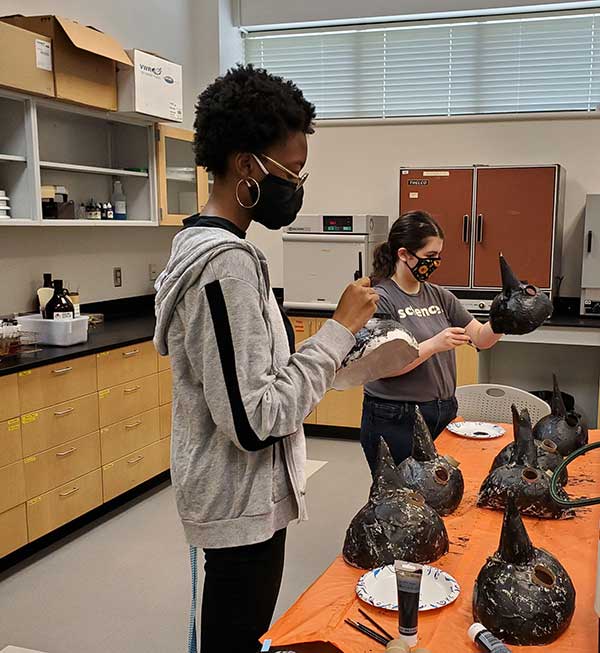Expect Chills & Thrills at Science Club’s 2020 Haunted Lab: The Science of Plagues
Author: News Bureau
Posted: Wednesday, October 21, 2020 12:00 AM
Categories:
Students | Faculty/Staff | Pressroom | School of Health and Natural Sciences | Events- Public
Cochran, GA

MGA students Gloria Adeola, left, and Zoe Roberson work on "plague doctor" masks they will wear while serving as guides at the haunted lab.
Science can be spooky.
Just in time for Halloween, Dr. Sharon Mozley-Standridge and student members of Middle Georgia State University's Science Club plan to give us a few spine-tingling examples. With the participation of other students and faculty members, they are hosting the third annual "Haunted Lab" from 6 to 7 p.m. Tuesday, October 27, on the Cochran Campus.
"The disciplines that make up science are how we gain knowledge about the natural world and ourselves," said Mozley-Standridge, associate professor of biology and the club's faculty advisor. "There are things in those worlds some people find creepy, but a little exploration can make things less frightening most of the time."
What are some of these “creepy” things?
Well, there's bioluminescence fungi, also known as “glowing mushrooms.” At last year's haunted lab, Mozley-Standridge discussed those eerie-looking living organisms. Or what about handwashing, something we all talk about a lot more these days? Quick experiments at last year’s event used some glow gel and a U.V. light to show how germ-y human hands can remain even when we think we’ve scrubbed them squeaky clean.
Another presentation at a previous haunted lab, led by a psychology instructor, was “What Are You Afraid Of?” The demo revealed how common it is for people to fear sticking their hands into a box when they don’t know what’s in it.
While not exactly Freddy Krueger-level frightening, the haunted lab spectacles generate enough chills to result in an entertaining and informative Halloween-season campus event.
“The haunted labs actually started as a ‘science night’ idea from Josiah Davis, one of our former students who graduated from MGA and is now working on his master’s degree in regenerative medicine at Cornell University,” Mozley-Standridge said. “We were not able to get one organized while he was here but the year after that the Science Club students managed to pull it off rather well. We choose a theme for each haunted lab, such as ‘Things That Glow in the Dark’ and ‘Fear.’ We have done the haunted labs in conjunction with other student clubs. For two years the Art Club created a haunted house near the haunted lab.”
This year’s haunted lab theme is “The Science of Plagues.” (In 2020, what else could it be?) Faculty members and Science Club students will set up several stations with presentations about specific plagues and related topics. Student members of MGA’s Goth Culture Club and others will wear macabre bird masks they are making to serve as “Plague Doctor” guides.*
Stations will feature:
- Mozley-Standridge, who will discuss science related to plagues. She will cover the ‘Black Death,’ (13th century plague in Europe), smallpox, flu, Ebola, and COVID-19.
- Dr. Clinton Ready, who will discuss “Bringers of Death” as examples of disease vectors (things that can transmit disease from a source to an individual) and more. His student assistant will be Varun Narra.
- Dr. Andrew Reeves, discussing the history of plagues. His student assistant will be Zoe Roberson.
- Kirby Swenson, discussing how organisms teach about life, even after death. (His station will include skulls!)
- Via Zoom, Dr. Lauren A. Byrd-Leotis, a virologist with the Department of Microbiology and Immunology at Emory University, will briefly introduce her work on influenza and take a few questions.
Admission to the haunted lab is free but the Science Club is accepting donations to help fund future activities. The event will take place in the auditorium and lobby of Dillard Hall on MGA’s Cochran Campus. Members of the public are welcome. Masks and social distancing are required.
*Here is a link to an article that explains the origins of the plague doctor: https://www.nejm.org/doi/full/10.1056/NEJMp2011418
